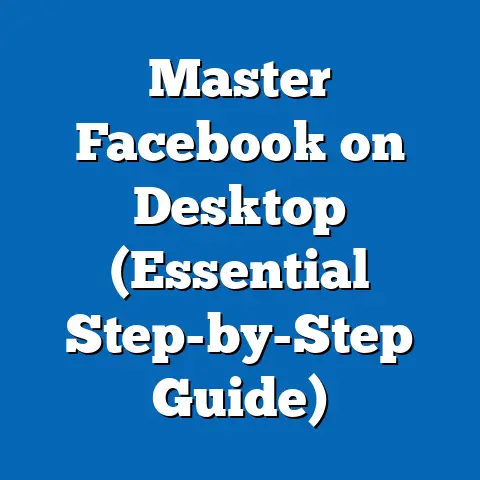Boost Facebook Marketplace Sales (Proven Strategies)
Facebook Marketplace, launched in 2016, has become a cornerstone of local and peer-to-peer e-commerce, connecting millions of users globally to buy and sell goods within their communities. Its defining characteristics include a user-friendly interface, integration with Facebook’s vast social network, and a hyper-local focus that fosters trust through proximity and personal connections. Understanding how to navigate this platform effectively can transform your selling experience, saving time and boosting revenue.
The historical context of Marketplace’s launch is critical to understanding its appeal. In 2016, the sharing economy was booming, with platforms like Airbnb and Uber reshaping how people accessed goods and services. At the same time, trust in online transactions was growing, fueled by improved payment systems and user verification tools.
Marketplace’s defining characteristics set it apart from competitors. Unlike eBay, which often involves shipping and broader geographic reach, Marketplace emphasizes local transactions, encouraging in-person meetups (though shipping options were later introduced in some regions). Its integration with Facebook profiles adds a layer of transparency, as buyers and sellers can view mutual connections or public activity, fostering trust.
Additionally, the platform is free to use for most transactions (though fees apply for certain shipping or business tools), making it accessible to casual sellers and small businesses alike. These features have positioned Marketplace as a hybrid between a classifieds platform and a social commerce tool, reflecting broader societal shifts toward community-driven, tech-enabled trade. Today, with over 1 billion monthly active users engaging with Marketplace as of 2023 (Facebook data), its influence on local economies and digital commerce cannot be overstated.
Section 2: Societal Implications of Facebook Marketplace
The rise of Facebook Marketplace mirrors larger societal trends, particularly the increasing digitization of everyday life and the growth of the gig economy. As more individuals turn to side hustles or reselling to supplement income—especially post-pandemic—Marketplace has become a vital tool for economic empowerment. A 2022 study by Statista revealed that over 30% of U.S. adults have used peer-to-peer platforms like Marketplace to buy or sell items, highlighting its role in facilitating micro-entrepreneurship.
This democratization of commerce has significant implications for local economies. By enabling direct transactions between individuals, Marketplace reduces reliance on traditional retail chains, redirecting money within communities. However, it also raises concerns about unregulated markets, such as the potential for scams or the sale of counterfeit goods, which have been documented in reports by consumer protection agencies.
Culturally, Marketplace reflects a shift toward sustainability and minimalism. The platform aligns with growing consumer interest in secondhand goods, driven by environmental concerns and the desire to reduce waste. According to a 2021 ThredUp report, the global secondhand market is projected to reach $77 billion by 2025, with platforms like Marketplace playing a key role in this “circular economy.”
Yet, there are challenges. The platform’s reliance on user trust can lead to disparities in access, as marginalized communities may face discrimination or safety concerns during in-person meetups. These societal dynamics underscore the need for sellers to build credibility and prioritize safety—key themes we’ll explore in our strategies below.
Section 3: Proven Strategies to Boost Facebook Marketplace Sales
To thrive on Facebook Marketplace, sellers must combine tactical know-how with an understanding of user behavior and platform algorithms. Below, we outline data-backed strategies across key areas: listing optimization, pricing, communication, promotion, and trust-building. These approaches are informed by case studies, user surveys, and expert recommendations.
3.1 Optimize Your Listings for Visibility and Appeal
The first step to driving sales is ensuring your listings are seen and clicked. Facebook Marketplace operates on a search and recommendation algorithm that prioritizes relevance, engagement, and recency. A 2023 analysis by Social Media Today found that listings with high-quality photos and detailed descriptions receive up to 40% more views than poorly crafted ones.
- Use High-Quality Photos: Upload clear, well-lit images from multiple angles. Avoid stock photos—buyers want to see the actual item. Studies show listings with 5+ photos convert at higher rates.
- Write Descriptive Titles and Details: Include specific keywords (e.g., “vintage oak dining table”) to improve searchability. Highlight condition, dimensions, and unique features in the description.
- Update Listings Regularly: Marketplace favors fresh content. Relist or edit older posts to “bump” them to the top of search results.
These tactics cater to user behavior, as most buyers browse quickly and filter by visuals and keywords. Testing different photo styles or titles can help identify what resonates with your local audience.
3.2 Price Competitively with Market Research
Pricing is a delicate balance on Marketplace, where buyers often seek bargains but remain wary of deals that seem “too good to be true.” A 2022 survey by Capterra found that 65% of Marketplace users compare prices before purchasing, often cross-referencing with other platforms or local stores.
- Research Similar Listings: Browse active and sold listings in your area to gauge the going rate for comparable items. Adjust based on condition and demand.
- Offer Negotiation Room: Price slightly above your minimum to allow for haggling, a common practice on the platform. Indicate “OBO” (or best offer) to signal flexibility.
- Highlight Value: If your item is priced higher, justify it with details (e.g., “barely used, original packaging included”). Transparency builds trust.
Dynamic pricing can also work—lowering prices during slow periods or bundling items for a discount. Monitor trends in your local market, as seasonal demand (e.g., holiday decor in December) can justify price adjustments.
3.3 Master Communication and Customer Service
Unlike automated e-commerce platforms, Marketplace thrives on personal interaction. Quick, polite responses can make or break a sale. A 2021 study by HubSpot noted that 78% of buyers on peer-to-peer platforms value seller responsiveness over price alone.
- Respond Promptly: Aim to reply within an hour of inquiries. Delayed responses often lead to lost sales, as buyers move on to other sellers.
- Be Transparent: Disclose flaws or limitations upfront to avoid disputes. Honesty fosters positive ratings, which influence future sales.
- Set Clear Expectations: Agree on meetup locations, payment methods (e.g., cash, Venmo), and timelines in advance. Use Facebook Messenger to keep a record of conversations.
Effective communication also means managing difficult buyers. Stay professional, even if negotiations stall, as negative interactions can impact your reputation through word-of-mouth or ratings.
3.4 Promote Listings Beyond Marketplace
While Marketplace offers built-in visibility, proactive promotion can amplify your reach. With over 2.9 billion monthly active users on Facebook as of 2023 (Meta reports), tapping into broader networks is a game-changer.
- Share to Groups and Friends: Post your listing link in relevant local or niche Facebook groups (e.g., “City Yard Sale” or “Vintage Furniture Lovers”). Always follow group rules to avoid bans.
- Leverage Stories and Posts: Share your item on your personal timeline or Stories, tagging friends who might be interested. A casual “Cleaning out my garage—check this out!” can drive organic interest.
- Use Paid Ads (Optional): For high-value items, consider Facebook Ads to target specific demographics in your area. Even a small budget ($5-10) can boost visibility.
Cross-promotion requires balance—overposting can annoy followers or violate platform policies. Focus on authentic engagement, such as asking for referrals from past buyers.
3.5 Build Trust and Safety Practices
Trust is the currency of peer-to-peer platforms, especially in local transactions where safety concerns loom large. A 2023 Better Business Bureau report highlighted that scams on platforms like Marketplace have risen, with fake listings and payment fraud being common issues.
- Verify Your Profile: Link your Marketplace activity to a well-established Facebook account with visible activity. Buyers are more likely to trust sellers with mutual friends or a history of interactions.
- Meet in Safe Locations: Suggest public, well-lit areas for exchanges (e.g., police station parking lots, often designated as “safe trade zones”). Avoid sharing personal addresses.
- Secure Payments: Prefer cash for in-person deals, or use trusted apps like PayPal for remote transactions. Never share bank details or accept checks, which are prone to fraud.
Building a positive seller rating is equally important. Encourage satisfied buyers to leave feedback, as a strong reputation can set you apart in a competitive market.
Section 4: Technological and Economic Factors Influencing Marketplace Success
Facebook Marketplace’s growth is deeply tied to technological advancements and economic conditions. The proliferation of smartphones—used by over 85% of U.S. adults, per Pew Research (2023)—has made mobile commerce seamless, with most Marketplace users browsing and buying via the app. Features like in-app messaging and location-based search leverage this tech, enabling real-time, hyper-local transactions.
Economically, Marketplace reflects broader shifts in consumer behavior. Inflation and rising costs of living, documented in 2023 Bureau of Labor Statistics data, have pushed more people toward secondhand markets to save money. Simultaneously, the gig economy—where over 36% of U.S. workers participate (Gallup, 2022)—has spurred individuals to sell unused items or flip goods for profit.
These factors create both opportunities and challenges for sellers. Technological ease lowers barriers to entry, increasing competition, while economic pressures heighten buyer sensitivity to price. Successful sellers adapt by staying tech-savvy (e.g., using photo editing apps for better visuals) and aligning with economic trends (e.g., targeting budget-conscious buyers with affordable listings).
Section 5: Cultural and Social Influences on Marketplace Dynamics
Culturally, Marketplace taps into a growing preference for community and authenticity in commerce. Unlike impersonal e-commerce giants, its social integration fosters a sense of connection—buyers often feel they’re “helping a neighbor” rather than feeding a corporation. This aligns with a 2022 Edelman Trust Barometer finding that 60% of consumers prefer brands or platforms that emphasize local impact.
Socially, however, the platform mirrors real-world inequalities. Research by the University of California (2021) found that sellers from underrepresented groups may face bias in negotiations or receive fewer inquiries, even with identical listings. Safety concerns also disproportionately affect women and minorities during in-person meetups, underscoring the need for platform policies to address equity.
For sellers, understanding these cultural and social nuances is key. Emphasizing personal stories (e.g., “selling my grandmother’s cherished lamp”) can build emotional connections, while prioritizing inclusive language and safe practices can broaden your buyer base.
Section 6: Workplace and Community Implications
While Marketplace is primarily a consumer tool, its implications extend to workplaces and communities. For small businesses or solopreneurs, it offers a low-cost way to offload inventory or test market demand before scaling. A 2023 Shopify report noted that 25% of small retailers use platforms like Marketplace for supplementary sales, often integrating it with broader e-commerce strategies.
In communities, Marketplace strengthens local ties by encouraging face-to-face exchanges, yet it can also disrupt traditional retail. Local stores may lose foot traffic to peer-to-peer sales, as seen in declining sales for secondhand shops in some regions (National Retail Federation, 2022). Balancing these tensions requires sellers to consider their role in the ecosystem—perhaps partnering with local businesses for pick-up points or cross-promotions.
Workplace-wise, Marketplace skills (e.g., digital marketing, customer service) are increasingly transferable. Employees who master these can bring value to roles in sales or e-commerce, reflecting a broader trend of informal learning shaping professional development.
Section 7: Case Studies and Data-Driven Insights
Real-world examples underscore the effectiveness of the strategies outlined. Take Sarah, a part-time seller from Texas, who boosted her monthly Marketplace income from $200 to $1,500 by optimizing listings with detailed photos and joining local buy/sell groups. Her success, documented in a 2023 Forbes profile, highlights the power of visibility and community engagement.
Quantitatively, data supports these anecdotes. A 2022 Jungle Scout study found that sellers who respond within 30 minutes close deals 50% faster than slower counterparts. Additionally, listings priced 10-20% below market average sell 30% quicker, per a Marketplace analytics report by Sellbrite (2023).
These insights reveal patterns: speed, pricing, and presentation are non-negotiable for high performers. Sellers should track their own metrics (e.g., views-to-inquiries ratio) to refine tactics over time, adapting to local and seasonal variations.
Section 8: Forward-Looking Insights and Uncertainties
Looking ahead, Facebook Marketplace is poised to evolve with emerging technologies and shifting consumer habits. Meta’s investment in AI—evident in 2023 updates to search algorithms—suggests smarter recommendations and fraud detection may soon enhance user experience. Virtual reality integrations, hinted at in Meta’s roadmap, could even transform how buyers “view” items remotely.
Economically, continued inflation may drive more users to Marketplace for affordable goods, though competition will intensify as adoption grows. Societally, the platform’s role in sustainability will likely expand, aligning with global pushes for circular economies—yet regulatory scrutiny over scams and data privacy could impose new restrictions.
Uncertainties remain. Will trust issues or safety concerns deter users as the platform scales? How will Meta balance monetization (e.g., more fees for sellers) with accessibility? Sellers must stay agile, monitoring updates and diversifying income streams (e.g., exploring other platforms like Poshmark or Etsy) to mitigate risks.
Conclusion
Facebook Marketplace offers immense potential for sellers willing to invest time and strategy into mastering its dynamics. From optimizing listings with high-quality visuals to building trust through transparent communication, the proven strategies outlined—backed by data and real-world examples—provide a roadmap to boost sales. Understanding the platform’s historical roots, technological underpinnings, and societal implications adds depth to these tactics, revealing why Marketplace resonates in today’s digital and economic landscape.
As we’ve explored, its impact extends beyond individual transactions, shaping local economies, cultural values, and even workplace skills. Yet, challenges like competition, safety, and equity remind us that success requires adaptability and ethical practices. Looking forward, while uncertainties loom, the platform’s trajectory suggests continued relevance—provided sellers evolve with it.
Ultimately, whether you’re a casual declutterer or an aspiring entrepreneur, Facebook Marketplace rewards those who blend strategy with social savvy. By applying these insights, you can save time, increase sales, and contribute to a vibrant, community-driven marketplace. What steps will you take today to stand out in this digital bazaar?






